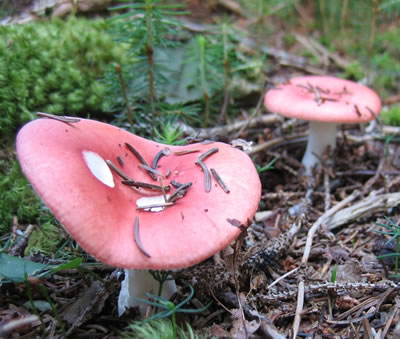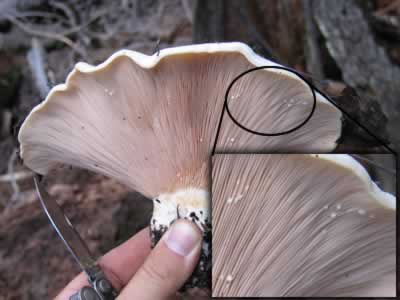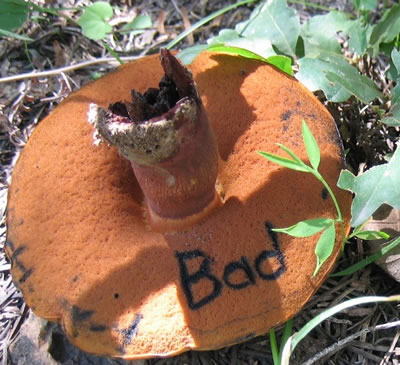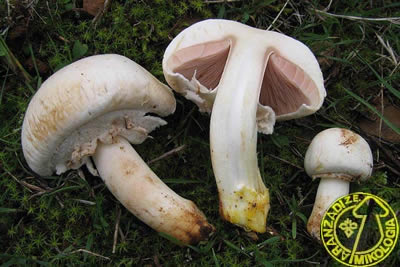Tissue and Color Change
For some mushrooms, important diagnostic properties are determined by damaging the flesh. The tests for color changes are almost always genus or even species specific, so are useful only after you have already identified the mushroom down to genus level. I've included tissue properties in this section specifically for the uniqueness of the family Russulaceae (Russula and Lactarius).
Brittle tissue
Members of the genus Russula and Lactarius have a flesh composition that is completely different from any other mushroom. The filamentous hyphae that form their tissues are interrupted by round cells called sphaerocysts, which give their flesh a crumbly, chalky texture.
The diagnostic test for wether you have a member of Russulaceae is the "stem snap". If you hold onto an intact stem, and attempt to break it as you would a pencil or a piece of chalk, it should fracture cleanly, whereas other mushrooms would bend or leave behind strings of flesh like breaking a live branch. Similarly, members of Russulaceae will crumble in your hand, or explode into pieces if thrown against a tree.

Bleeding milk
Members of Lactarius have an additional diagnostic feature that they express when damaged. As you might guess from their name, most Lactarius will release a milky fluid when damaged, especially along the gills near the stem. Old and dry mushrooms are less likely to "lactate".
The color of the milk is the key to identification. There are some general rules about the edibility of a Lactarius based on the color of the exudate, but as always a proper ID requires a combination of characters.

Bruising blue
Members of Boletales are well known for their bruising color changes. Bruising is a term that also applies to color change when cut, and typically cutting the flesh will produce a more dramatic result. The most common color change in Boletus is bruising blue. Other members of Boletales such as Tylopilus, Suillus, and Leccinum can bruise brown, black, yellow, and pink.
You will need to consult your ID guide, which should mention which species bruise which colors, and how strongly. The example on the right is Boletus pulcherrimus, which turns dramatically blue when damaged!

Bruising yellow
While there are several mushroom genera that can stain yellow when damaged, staining reactions in the genus Agaricus are critical for determining edibility. The genus Agaricus contains some of the best edibles, but also several highly poisonous species. As you will remember (or already knew), Agaricus contains the portabello, cremini, and white button mushrooms. Far tastier varieties are not commonly cultivated, and are highly sought after by foragers.
The most infamous of the poisonous Agaricus is Agaricus xanthodermus, the yellow staining meadow mushroom. This mushroom bears close resemblance to the popular edible meadow mushroom, but turns bright yellow when its cap is rubbed or the base of the stem is cut. You must note that yellow staining is not by itself an edibility criteria; there are yellow staining edible Agaricus out there. A. xanthodermus just has an especially strong staining reaction it is well known for.

Photo: See stamp.